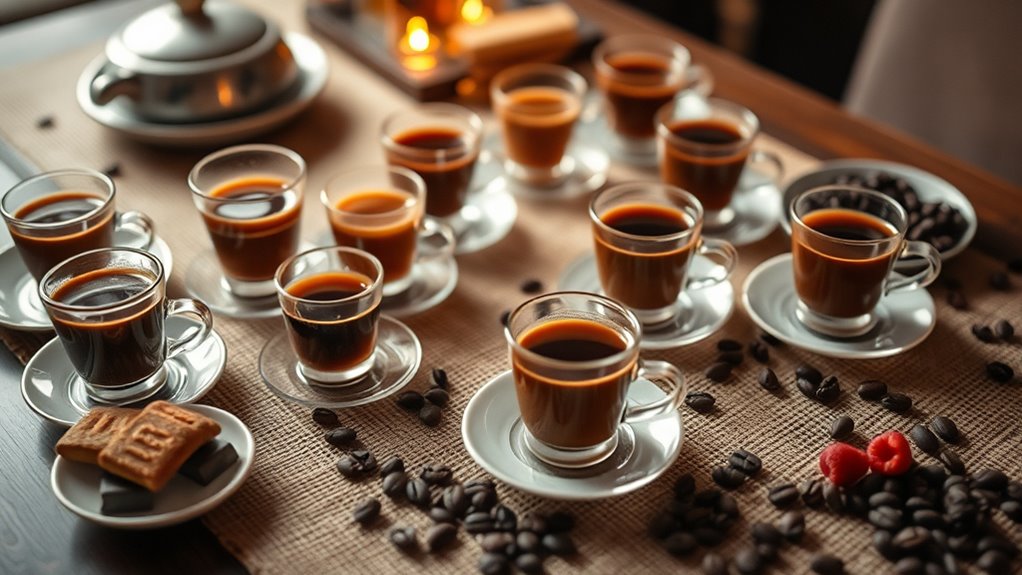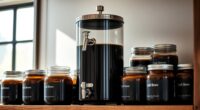To host a coffee tasting party, select a variety of specialty coffees with different origins, roasts, and brewing methods to keep things interesting. Prepare each sample freshly and brew at the right temperature to preserve flavor. Encourage guests to smell, slurp gently, and describe what they taste. Create a relaxed atmosphere with snacks and educational insights about coffee traditions. If you continue exploring, you’ll discover how to make your event memorable and engaging.
Key Takeaways
- Select diverse specialty coffees with varied origins, roasts, and brewing methods to create an engaging tasting lineup.
- Prepare each coffee freshly and consistently at around 200°F, allowing it to cool slightly before tasting.
- Encourage deep smelling, slurping, and sensory descriptions to explore aroma, flavor, body, and acidity.
- Create a relaxed atmosphere, pair coffees with snacks, and share cultural insights to enhance enjoyment and learning.
- Foster curiosity and conversation to deepen appreciation, sensory perception, and understanding of coffee profiles.

Ever wondered how to truly appreciate the complex flavors of different coffees? Hosting a coffee tasting party is a fantastic way to deepen your understanding of coffee profiles and share that experience with friends. These events revolve around exploring aroma, acidity, body, and flavor, allowing you to evaluate coffee samples from various origins, roasts, and processing methods.
To create an engaging tasting event, start by selecting a diverse lineup of specialty coffee, ensuring you include different roasting levels and brewing techniques. This variety provides a rich sensory experience and helps guests learn about the nuances of each coffee.
Select a diverse range of specialty coffees with varied roasts and brewing methods to enrich your tasting experience.
Proper preparation is key. Use freshly ground coffee grounds for each sample, as this maintains the integrity of the aroma and flavor. Brew each coffee at approximately 200°F to extract ideal flavors, and then allow the coffee to cool slightly before tasting. This step is vital because hot coffee can mask subtle notes, while cooled coffee provides a more accurate sensory analysis.
When presenting the coffee samples, encourage guests to smell deeply, focusing on aroma evaluation before sipping. The aroma often hints at flavor notes like fruity, nutty, or floral qualities, setting the stage for a well-rounded tasting.
During the tasting, emphasize techniques like slurping gently to spray the coffee across your palate. This allows you to experience the coffee’s body and acidity more fully. As you taste, describe sensory impressions—whether the coffee feels bright, smooth, bitter, or sweet. This kind of sensory analysis helps everyone appreciate the complexity of each brew.
Organizing a variety of coffee origins and roasting levels ensures that each guest encounters a broad spectrum of flavors, heightening their sensory awareness and understanding of coffee profiles.
Understanding coffee culture and its diverse traditions can enrich the tasting experience, making it more educational and culturally immersive.
Pairing the coffee with complementary snacks can elevate the tasting experience. Think of light pastries, fruit, or nuts that enhance specific flavor notes without overpowering the coffee itself.
Creating a relaxed, inviting atmosphere encourages conversation and curiosity, making the event educational and enjoyable. As your guests explore different coffees, they’ll develop a keener sense of aroma, acidity, and flavor nuances.
Frequently Asked Questions
How to Host a Coffee Tasting Event?
To host a coffee tasting event, start by selecting 3-5 unique coffee samples from different origins and roasts.
Set up tasting stations with labeled cups, clean brewing equipment, and tasting notes.
Invite your guests to sniff aromas, slurp to taste, and describe flavors.
Add food pairings like chocolates or pastries, and encourage discussion and scoring.
Keep the atmosphere relaxed and fun, maybe with quizzes or blind tastings for extra engagement.
What Are the 4 Steps of Coffee Tasting?
You start by smelling the coffee to detect its complex aromas, then slurp to aerate and assess the flavor nuances and acidity.
Next, locate the flavor in different parts of your mouth, like the tip, sides, and back, to understand its texture.
Finally, describe what you’ve experienced by noting aroma, flavor notes, acidity, body, and aftertaste, giving a complete picture of the coffee’s profile.
How to Host a Coffee Event?
When hosting a coffee event, start by selecting a variety of beans with different origins and flavor profiles to keep it interesting.
Set up a tasting station with labeled samples and notes, and prepare the brewing equipment ahead of time.
Serve the coffee at the right temperature, and guide your guests through aroma exploration and tasting techniques.
Encourage discussion and comparisons to make the experience engaging and educational for everyone.
How to Serve Coffee to Guests in a Party?
When serving coffee to guests, use small, uniform cups like espresso or tasting-sized ones to enhance aroma and flavor.
Clearly label each coffee with details like origin and roast level, and keep the temperature around 150-160°F for the best experience.
Provide palate cleansers such as water or crackers between samples, and arrange the stations logically, from light to dark roasts, to create a smooth tasting journey for your guests.
Conclusion
Hosting a coffee tasting party is a fun way to explore new flavors and connect with friends. Just choose a variety of beans, set up tasting stations, and encourage everyone to share their impressions. Keep it relaxed and enjoyable, and don’t forget to have some tasty snacks and cups ready. With a little planning, you’ll create a memorable experience that everyone will look forward to repeat. Cheers to great coffee and even better company!









